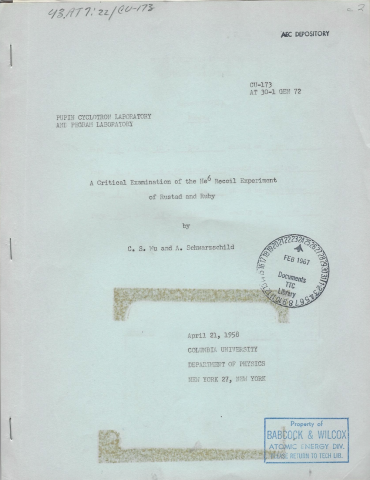A Critical Examination of the He6 Recoil Experiment of Rustad and Ruby

The He6 experiment was investigated to decide whether any systematic errors due to oversight could have affected their interpretation, which indcates tensor interaction. It is concluded that some corrections which the authors neglected in their calculations were substantial enough to make their conclusion questionable. A precise correction of the measured coincidence results was found to be impossible due to the semitransparency and multiple scattering effect of the diaphragm holes. (M.H.R.)
The latest results of A35 strongly indicate a vector-interaction in Fermi transition. The evidence of the recoil experiment by Rustad and Ruby has been considered rather conclusively for tensor interaction. So here we are in a predicament!; It is therefore highly desirable to look carefully into the experiment and decide whether any systematic errors due to oversight could have affected their interpretation.
,The following is a report of such an investigation, and the conclusion is that unfortunately some corrections which the authors neglected in their calculations turned out to be quite substantial and rendered the conclusion which they originally made definitely questionable.
,The purpose of the re-examination is to point out the detrimental effects on the correlation results due to the presence of even a small quantity of He6 gas in the diaphragm holes. Furthermore, by using an optical analog it has been possible to infer directly the pressure gradient of He6 along the chimney hole and therefore substantiate our supposition. This is, unfortunately, what happened.
,Acknowledgments. We wish to thank Dr. Richard Garwin and Dr. Luke Yuan for many valuable discussions concerning the measurement of the gas pressure gradient. We particularly want to thank Mr. K. Lattemann for his patient help in carrying out the investigation of the angular variation effect. To Mr. B. Rustad and Mr. S. Ruby we express our thanks for their cooperation.